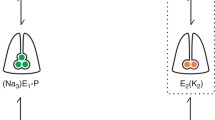Abstract
The influence of ouabain and physostigmine on42K and86Rb uptake in isolated frog sartorii with normal [Na] i (12–14 mmol·kg−1 wet weight) and low [Na] i (6 mmol·kg−1 wet weight) was compared. Both in normal-sodium and in low-sodium muscles application of 10−3 M physostigmine reduces potassium influx by about 70%. About one fourth of potassium-uptake in normal-sodium muscles is inhibited by ouabain (10−4M) and only a very slight fraction of potassium uptake is ouabain-sensitive in low-sodium muscle. The effects of ouabain and physostigmine on42K influx are additive. The greater parts of the Rb-fluxes are through the ouabainsensitive pathway. Glycerol treatment has no effect on ouabain-sensitive channels although it inhibits markedly the K-flux through the physostigmine-sensitive pathway. The results suggest that the Na−K-ATPase is located in the surface membrane while most of the physostigmine-sensitive K-exchange is within the tubules.
Similar content being viewed by others
References
Adrian RH, Slayman CL (1964) Pumped movements of K and Rb in frog muscle. J Physiol (Lond) 175:49–50P
Beaugé LA, Medici A, Sjodin RA (1973) The influence of external caesium ions on potassium efflux in frog skeletal muscle. J Physiol (Lond) 228:1–11
Bolingbroke V, Harris EJ, Sjodin RA (1961) Rubidium and caesium ions on potassium efflux in frog skeletal muscle. J Physiol (Lond) 157:289–305
Caldwell PC, Keynes RD (1966) The exchange of22Na between frog sartorius muscle and the bathing medium. In: Passow H, Stämpfli T (eds) Laboratory techniques in membrane biophysics. Springer, Berlin Heidelberg New York, pp 63–68
Eisenberg B, Eisenberg RS (1968) Selective disruption of the sarcotubular system in frog sartorius muscle. J Cell Biol 39: 451–467
Eisenberg RS, Gage PW (1969) Ionic conductances of the surface and transverse tubular membranes of frog sartorius fibres. J Gen Physiol 53:279–297
Fujino M, Yamaguchi T, Suzuki K (1961) “Glycerol effect” and the mechanism linking excitation of plasma membrane with contraction. Nature 192:1159–1161
Henderson EG (1970) Potassium exchange and afterpotentials in frog sartorius treated with glycerol. J Gen Physiol 56:629–715
Horowicz P, Taylor JW, Waggoner DM (1970) Fractionation of sodium efflux in frog muscles by strophantidin and removal of external sodium. J Gen Physiol 55:401–425
Howell JN (1969) A laesion of the transverse tubules of skeletal muscle. J Physiol (Lond) 201:515–533
Howell JN, Jenden DJ (1967) T-tubules of skeletal muscle: morphological alterations which interrupt excitation-contraction coupling. Fed Proc 26:553
Keynes RD, Steinhardt RA (1968) The components of sodium efflux in frog muscle. J Physiol (Lond) 198:581–599
Kovács T, Szabó B (1972) Effect of physostigmine on sodium influx into frog sartorius muscle. Acta Physiol Acad Sci Hung 42:367–375
Krolenko SA (1969) Changes in the T-system of muscle fibres under the influence of influx and efflux of glycerol. Nature (Lond) 221:966–968
Krolenko SA, Fedorov VV (1972) Recovery of isometric twitches after glycerol removal. Experientia (Basel) 28:424–425
Nakajima S, Nakajima Y, Peachey LD (1973) Speed of repolarization and morphology of glycerol-treated frog muscle fibres. J Physiol (Lond) 234:465–480
O'Donnell JM, Kovács T, Szabó B (1975) Influence of membrane stabilizer diphenylhydantoin on potassium and sodium movements in skeletal muscle. Pflügers Arch 358:275–282
Sjodin RA (1971) Ion transport across excitable cell membranes. In: Adelman WJ, Jr (ed) Biophysics and physiology of excitable membranes. Van Nostrand Reinhold Comp, New York, pp 98–120
Sjodin RA, Beaugé LA (1968) Strophantidin-sensitive components of potassium and sodium movements in skeletal muscle as influenced by the internal sodium concentration. J Gen Physiol 52:389–407
Varga E, Horowicz P (1963) Effect of eserine on potassium permeability of frog striated muscle membrane. Fed Proc 22:565
Venosa RA, Horowicz P (1974) Effects on sodium efflux of treating frog sartorius muscles with hypertonic glycerol solution. J Membr Biol 14:33–56
Zachar J, Zacharová D, Adrian RH (1972) Observation on “detubulated” muscle fibres. Nature (Lond) New Biol 239:153–155
Zacharová D, Uhrik B (1978) Kinetics of functional and morphological changes during decoupling and recoupling induced by glycerol in isolated muscle fibres of the crayfish. Cell Tiss Res 192:167–185
Author information
Authors and Affiliations
Rights and permissions
About this article
Cite this article
Kovács, T., Pfliegler, G. & Szabó, B. The subcellular location of potassium flux pathways in frog skeletal muscle. Pflugers Arch. 390, 250–255 (1981). https://doi.org/10.1007/BF00658270
Received:
Accepted:
Issue Date:
DOI: https://doi.org/10.1007/BF00658270



